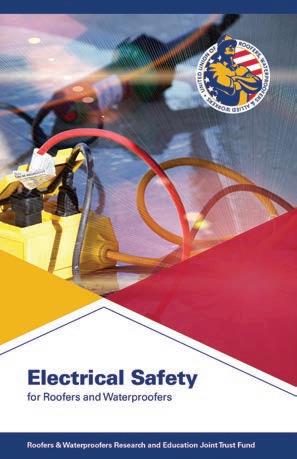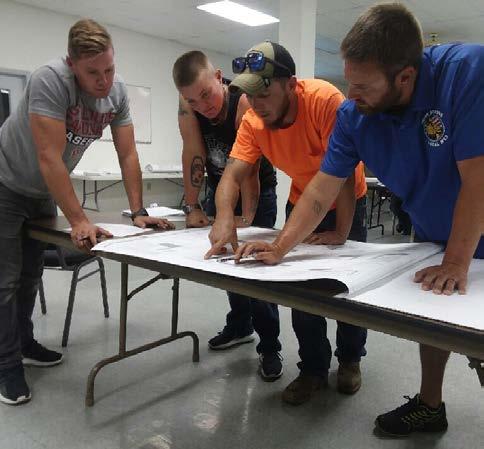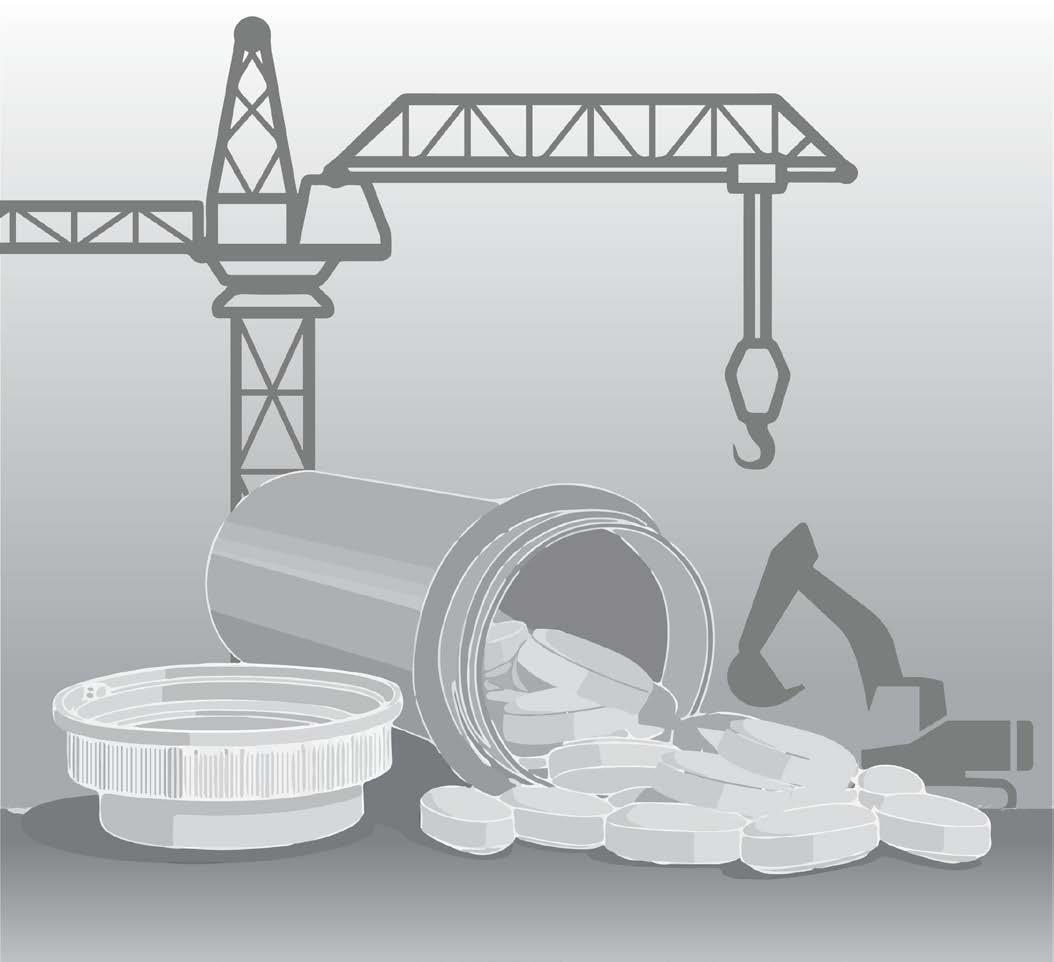
8 minute read
Research and Education Trust
BY KEITH J. VITKOVICH, EXECUTIVE DIRECTOR OF ROOFERS & WATERPROOFERS RESEARCH AND EDUCATION TRUST FUND
Advertisement
In order to stay current with the latest roofing safety standards and deliver the most advanced training possible, the Roofers & Waterproofers Research and Education Joint Trust Fund (Roofers Joint Trust) continues to develop new training resources for local unions and JATCs to utilize during apprentice and journeyperson training.
In the fast-changing world of roofing safety standards and practices, the Roofers Joint Trust’s most recent development turns its focus to creating a comprehensive safety and health guide based on the latest information available. The result is the brand-new Safety and Health Training package, offering a wealth of resources for instructors to conduct independent safety awareness classes. In particular, it is the complete resource program for the use of authorized instructors to conduct OSHA 10 and 30 hour courses. This package includes:
• Electronic presentation instructions
• 20 student booklets
• 20 electronic presentations
The training package has a fullcolor look, produced in a format that will allow the Roofers Joint Trust to make timely revisions and updates-as required upon any OSHA standard changes or requirements.
The 20 student booklets include OSHA standards/regulations, industry practices, references, and real life illustrations. The 20 instructor-led electronic presentations augment the student booklet materials and other interactive features that support the learning objectives and enhance the learning process. Each slide is connected to the material it covers in the student text, and talking points are suggested for each slide to help the instructor conduct the class.
Print versions of these materials are available for order and can be downloaded from the Training Resource Center (TRC). This approach again allows us to print the latest versions of the training resources and avoids having a large inventory of older versions to deal with.
The training package consists of the following subjects:

• Confined Spaces • Cranes and Derricks
• Electrical Power Lines
• Electrical Safety • Ergonomics • Fall Protection
• Fire Hazards and Prevention
• Hearing Protection • Heat Illness Prevention
• GHS Labels and SDS
• Ladders and Stairways • Material Handling • Powered Equipment • PPE
• Respirators • Safety Culture • Scaffold Safety • Struck By/Caught-In/Or-Between • Tools Hand and Power • Weather Hazards ■
Roofers Foreman Training Program
The Roofers Foreman Training Program is designed to provide unions and their signatory contractors with a first-class training program for current and future foremen in the roofing and waterproofing industry.
The program is designed to accomplish the following:
• Improve the knowledge and ability of foremen to lead their jobs and supervise their crews so that they are safer and more efficient.
• Instill the necessary interpersonal skills that will retain apprentices and journeymen in our industry and bring jobs in on time and under budget. • Help ensure that the quality, efficiency and productivity of foremen and crews reach their maximum levels.
Information about the Modules
Topics
The exercises and information contained in these modules are about the skills determined to be critical for success through a survey of signatory contractors, union officials and working foremen. Each module addresses a series of skills as outlined below.
PART I – ROLE OF FOREMEN
❱ Communication Skills • The role of foreman
• Listening skills • Responding to worker concerns • Giving effective directions and instructions
❱ Problem Solving • Problems encountered by foremen • Avoiding and dealing with harassment • Valuing diversity and avoiding discrimination
❱ Math and Measurement • Review of basic math skills associated with roofing and waterproofing • Apply basic math skills to everyday duties as foremen • Review of equations for perimeter and area of different roof shapes • Find area of irregular-shaped roofs • Use math skills to calculate materials needed for roofing and waterproofing jobs
❱ Safety Skills • The role of foreman in safety • Safety practices and standards for roofers • Safety jeopardy • Identifying worksite hazards • Designing fall protection
❱ Teaching Skills • Determining learning style preferences • Demonstrating effective demonstrations • Giving a toolbox lesson
❱ Anti-Harassment Training • Identifying DOL/OA requirements associated with avoiding harassment • Recognizing that there are behaviors sometimes common to construction work sites that might be considered harassment
• Review of the most important ideas about preventing and dealing with harassment
PART II – MANAGING THE PROJECT AND THE WORKFORCE
❱ Reading Plans and Specifications • Name and explain the types of lines typically used on a set of drawings • Name and explain the different types of elevation drawings used in a set of prints • Demonstrate the use of an architect’s scale
• Work with a set of prints to find information and details
❱ Planning and Starting the Project • Explain the details of different types of job site set-ups • Identify who should be involved in the decision making of job setups • Explain why communicating with all parties involved is key when setting up a job • Identify what the main concerns are regarding a job set-up • Explain why the concerns for different job set-ups (new construction, tear-offs, etc.) are similar, but take on greater meaning the more complex the job is • Make better decisions on job set-ups in the future

Students at a 2019 Foreman Training class practice reading plans and specifications.
❱ Motivating and Reinforcing Workers • Explain different types of motivation • Explain various ways to motivate your crew • Identify de-motivating factors • Explain the importance of a job well done • Explain how to use rewards as motivators
❱ Leadership Styles • Identify the leadership styles you currently employ • Make improvements on your current leadership styles and expand on your leadership techniques • Identify and eliminate any leadership styles that are unprofessional, or that discredit your employer, your union, or yourself • Identify strategies for becoming more-effective leaders
❱ Documentation and Recording Information • Recognize the type of information that foremen typically must record and document • Review basic steps associated with recording and documentation
• Understand the importance of record keeping and documentation
Design
The materials’ design allows participants to engage actively in learning (these are not online training courses). Lecture is minimized, while interaction and activity is maximized. Additionally, participants are asked to reflect on their experience and share ideas with each other. Equally important, the activities are designed to be mixed and matched with each other and with other modules in the series so that an instructor can select any number of activities/exercises to accommodate the time available.
Time
The entire program—all 11 modules—is four full days in length. Delivery has been in two parts, each of which is two days in length.
Part I, which includes modules on Communications, Problem Solving, Math and Measurement, Safety Skills, Teaching Skills, and Anti-Harassment Training, is two days in length. Part II, which includes Reading Plans and Specifications, Planning and Starting the Project, Motivating and Reinforcing Workers, Leadership Styles and Documentation and Recording Information, is an additional two days in length.
Instructors
The program is currently co-taught by master instructors who are past foremen with extensive roofing experience.
Locals that have participated in Foreman Training (with a vast majority of them more than once):
2, 11, 12, 20, 23, 26, 27, 32, 33, 36, 37, 44, 49, 54, 58, 65, 69, 74, 96, 112, 119, 136, 142, 153, 162, 182, 195, 210, 220, 221. ■
Subscribe to us on YouTube
Visit www.youtube.com/c/UnitedUnionofRoofersWaterproofersAlliedWorkers and click “Subscribe” to follow all the latest video content supported by the United Union of Roofers, Waterproofers & Allied Workers!

Opioid Deaths in Construction
Construction work can result in painful injuries that are sometimes treated with prescription opioids. One in four people prescribed opioids for long-term pain become addicted* and opioid-related deaths are on the rise.
Chris’ Story
Chris strained his back after lifting heavy materials. He tried to ignore the pain, but it wouldn't go away. Chris went to the doctor and was prescribed an opioid to treat the pain. The pills reduced the pain, but his back never got better. Chris found that he needed the pills to make it through the day. Eventually, his doctor refused to give him another prescription. Chris went to another doctor and got a new prescription. Over time his job performance and family life began to suffer. Chris went back to his doctor and asked for help. His doctor helped him to find treatment for his opioid addiction. Chris is now in recovery and using a non-addictive treatment for his pain.

Have you known someone addicted to opioids? If a worker is injured and in pain, what should
he or she do to avoid becoming addicted to opioids? Remember This
Your employer must provide a safe work environment to prevent injuries. If you see a hazard on the job, report it to your supervisor or foreman. Follow safe work practices to prevent injuries, such as getting help when lifting heavy materials.
If you are injured, talk to your doctor about non-addictive medications or physical therapy to treat the pain. Opioids should be the last option, and if prescribed used for the shortest time possible. Addiction is an illness that can be treated.Get help if you find you are dependent on pain medication to get through the day. Check with your union or employer to find out if they have a program to help, such as an employee assistance program (EAP) ormember assistance program (MAP). Call this confidential national hotline to findout about treatment options near you 1-800-662-HELP (4357) or go online at https://resources.facingaddiction.org.
How can we stay safe today?

What will we do at the worksite to prevent an injury?
1.
2.
*Centers for Disease Control & Prevention. Promoting Safer and More Effective Pain Management. https://www.cdc.gov/drugoverdose/pdf/Guidelines_Factsheet-Patients-a.pdf

Opioid Deaths in Construction

Report hazards to your supervisor or foreman to prevent injuries. If you're injured, opioids are the last option. Talk to your doctor about non-addictive medications or other options to treat the pain. Need help with addiction?








